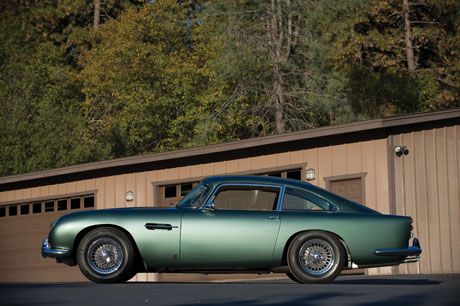SCM Analysis
Detailing
| Vehicle: | 1965 Aston Martin DB5 |
| Number Produced: | 886 |
| Original List Price: | $12,500 |
| Tune Up Cost: | $900 |
| Distributor Caps: | $83 |
| Chassis Number Location: | Engine compartment on right of scuttle |
| Engine Number Location: | Stamped on right side of block |
| Website: | http://www.amoc.org |
| Investment Grade: | B |
This car sold for $429,000, including buyer’s premium, at RM’s “The British Are Coming” auction in Phoenix, Arizona, on January 21, 2010.
Over the past decade, the DB5 has outshone those other classic price yardsticks the Ferrari Daytona, the Porsche Carrera RS 2.7, and the Jaguar E-type. As the RS inflated quietly, the Daytona dropped back for a time and E-types were more or less left to get on with it, the Aston Martin DB5 rose relentlessly at a similar rate to the market-leading Mercedes-Benz 300SL Gullwing.
Why? Against those other achingly beautiful 1960s coupes, 250 Ferraris, Astons always looked like good value, with more elegant interiors, and they’re arguably better constructed. Only about 880 DB5s were made against almost 1,000 GTEs and 350 Lussos, so as V12 Ferrari prices rise (record so far for a Lusso, $2.3m in 2007), DB5s look ever more attractive.
Don’t knock the lump
The most common complaint? It’s a straight-6. But its 4-liter has as much stonk as the Ferrari. Okay, compare it with the Maserati Mistral? Eight hundred thirty of those were made as coupes, and the auction peak was $150k in the U.K. in 2008. But the Maser is just too low-rent and gummy looking. Lambo 400 GT? Too weird, too rare, and you wouldn’t use the words “reliable” and “400 GT” in the same sentence. Unless you were telling a very funny joke.
Prices on the up?
DB5s have largely leveled off up until now, and although U.K. dealers are still asking up to £300k ($460k) for top cars, they can be had at auction for a lot less. Skimming recent high prices for cars in condition #2 or above from the SCM Auction Database gives us $391,020 (May 2008, U.K.), $375,990 (May 2009, U.K.) and $341,000 (August 2009, U.S.). The peak thus far (apart from a James Bond movie car that topped $2m in 2006) has been in May 2007 in the U.K. at $438k for a #3+ convertible that was expected to do rather less. The numbers therefore would suggest that they have peaked, and dropped back a little. Until now.
This was clearly a top car, well restored by acknowledged expert Kevin Kay Restorations, a concours winner (albeit at a minor California event), carefully stored since, and described as “flawless.” Left- to right-hand-drive conversions don’t seriously affect values, so going the other way shouldn’t either. The wide wheels and too-fat rubber were matters of taste and easy to replace if you didn’t like them. Simply, no issues unless you really wanted to create some. SCM’s Carl Bomstead, who was there, noted it as “a well restored example with a very nice tan leather interior.”
It was offered without reserve and expected to make $300k-400k, but kept going for another $30k after some sparring between bidders. Bomstead was watching and said, “I don’t know if I would call it a war, but it was certainly a battle. I think the ‘The British Are Coming’ Thursday night promotion raised all the offerings to a level a touch above expected.”
So the money was strong and it was well sold, though deservedly so. But was it as good as the really sharp Works Service-restored DB5 upgraded to 4.2 liters, which sold for $375,990 in May 2009? Perhaps not, but how much more might that car cost today?
I would suggest that, even with a little spur-of-the-moment checkbook competition going on, the market is picking up again. The next few sales will inform us whether this was a premature spike or emblematic of a trend.
